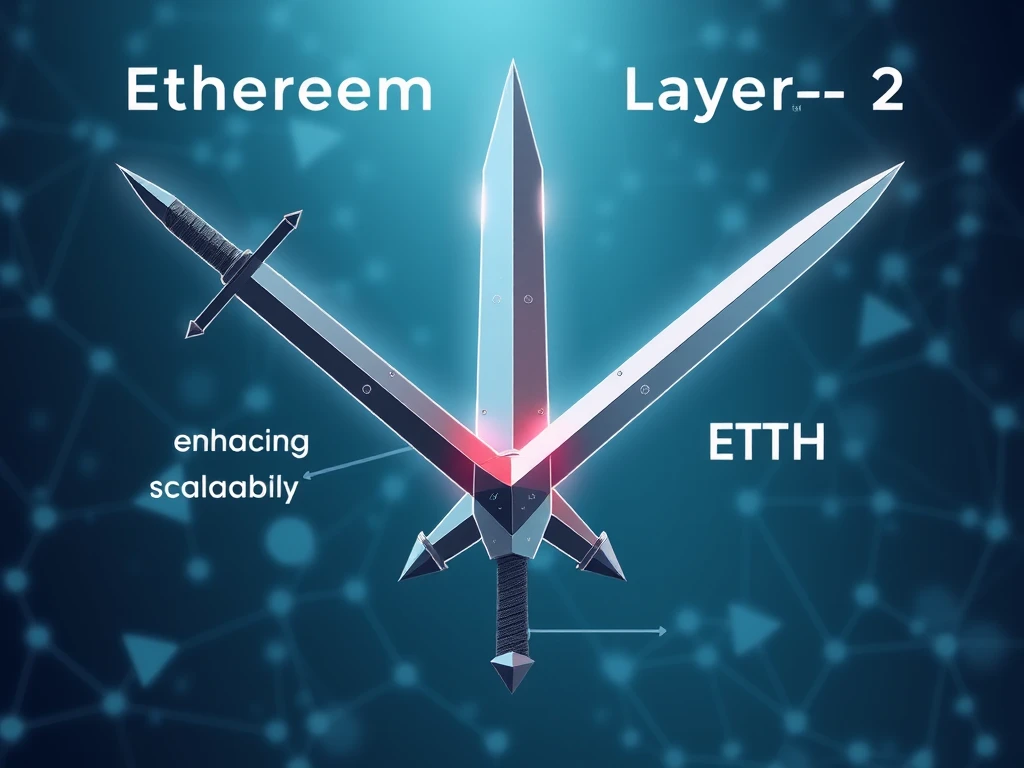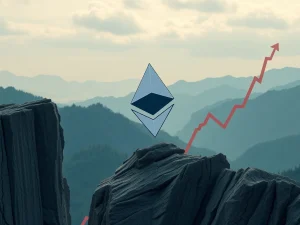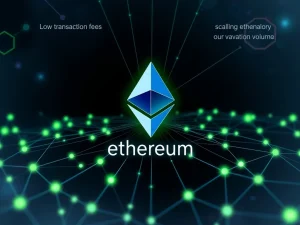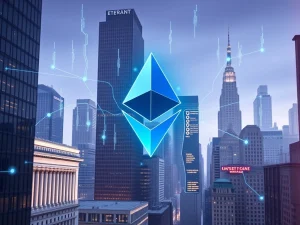Urgent Warning: Ethereum L2 Development’s Double-Edged Impact on ETH Value

Ethereum’s ambitious journey towards Layer-2 (L2) scalability is being hailed as revolutionary, but a recent report from Binance Research casts a shadow of doubt. Could this very development, designed to propel Ethereum to new heights, inadvertently clip the wings of its native token, ETH? The report suggests that while L2s promise faster, cheaper transactions, they might also be a ‘double-edged sword’ for ETH’s value. Let’s dive into this intriguing paradox and explore what it means for the future of Ethereum and your crypto portfolio.
The Double-Edged Sword of Ethereum L2 Development
Binance Research’s insightful report shines a spotlight on a potential downside of Ethereum’s L2 scaling solutions. The core concern? These L2 networks, built to alleviate congestion and reduce gas fees on the Ethereum mainnet, could inadvertently ‘cannibalize’ the base layer. This cannibalization effect, according to the report, stems from several factors that could negatively impact ETH value.
- Liquidity Dispersion: As L2s flourish, liquidity might spread across multiple chains, diluting the concentration and potentially the value on the Ethereum mainnet itself.
- Developer Mindshare Fragmentation: With more development activity shifting to L2s, the focus and resources might be less concentrated on the Ethereum base layer, impacting its growth and innovation.
- Reduced Value Accrual to L1: If transactions and activity predominantly move to L2s, the fees and value generated might primarily benefit the L2s rather than the Ethereum Layer 1 (L1), thus affecting ETH’s value accrual.
This paints a complex picture. While Ethereum scalability is crucial for its long-term success, the chosen path via L2s might present unforeseen economic challenges for ETH. The report emphasizes that Ethereum’s dominance in the decentralized exchange (DEX) arena is already facing pressure from competitors like Solana and BNB Smart Chain, primarily due to Ethereum’s historically slower and more expensive transactions.
| Blockchain | Challenge to Ethereum’s DEX Dominance |
|---|---|
| Solana | Faster transaction speeds and lower costs |
| BNB Smart Chain | Lower transaction costs and growing ecosystem |
The rise of L2s, while addressing transaction speed and cost, could further complicate Ethereum’s competitive landscape if not managed strategically.
Pectra and Fusaka Upgrades: Addressing Scalability, But Not Immediate ETH Value Accrual?
Ethereum’s roadmap includes significant upgrades aimed at bolstering its network. The upcoming Pectra upgrade, slated for May 7th, and the Fusaka upgrade, expected in late 2025, are crucial steps in this direction.
Pectra Upgrade: Focus on Staking and L2 Scalability
The Pectra upgrade is designed to enhance:
- Ether Staking: Improvements to make staking more efficient and accessible.
- L2 Network Scalability: Further optimizing the performance and capacity of L2 networks.
- Blob Capacity: Increasing the amount of data the mainnet can handle, crucial for supporting L2 operations.
- Overall Network Capacity: General improvements to boost the network’s throughput.
Fusaka Upgrade: Scaling Data Availability
The Fusaka upgrade will primarily focus on:
- Data Availability Layer Scaling: Transforming Ethereum into a robust data availability layer through EIP-7594.
- EVM Update: Potentially upgrading the Ethereum Virtual Machine to streamline smart contract creation, reduce overhead, and enhance developer experience.
While these upgrades are vital for long-term Ethereum scalability and network health, the Binance Research report suggests they might not directly and immediately solve the potential issues related to ETH value accrual in the face of L2 dominance. The upgrades are geared towards infrastructure and capacity, which are essential but may not directly translate to increased demand or value capture for ETH in the short to medium term.
Exploring Paths to Stronger ETH Value Accrual
The report isn’t all doom and gloom. It also highlights potential pathways to ensure ETH remains a valuable asset even with the proliferation of L2s. One promising avenue is the development and adoption of ‘based rollups’.
Based Rollups: A Potential Solution
Based rollups are L2 solutions that are designed to contribute significantly more fees back to the Ethereum mainnet compared to other L2s like Base, Arbitrum, and Optimism. This fee contribution can help in:
- Strengthening ETH Value Accrual: By directing more economic activity back to the mainnet.
- Aligning Incentives: Creating a more symbiotic relationship between L2s and the Ethereum base layer.
Ethereum as a Data Availability Layer: A Key Role
Another critical factor is Ethereum’s evolving role as a data availability layer. For this to effectively drive ETH value, certain conditions need to be met:
- L2 Preference for Ethereum DA: L2 networks must continue to choose Ethereum as their preferred data availability layer over alternatives like Solana or BNB Smart Chain.
- Growing Blockspace Demand: The demand for blockspace on Ethereum must increase in a competitive market where other blockchains are vying for attention.
The Path Forward: Incentive Alignment is Key
The Binance Research spokesperson aptly summarizes the crucial next step: aligning incentive structures between Ethereum and its L2s. This alignment could take various forms:
- Fee Sharing Mechanisms: Implementing systems where L2s share a portion of their transaction fees with the Ethereum mainnet.
- MEV Capture Strategies: Developing methods to capture Miner Extractable Value (MEV) and distribute it in a way that benefits ETH holders or the mainnet.
- Protocol-Level Integrations: Building deeper integrations at the protocol level to ensure a sustainable flow of value back to ETH.
Conclusion: Navigating the L2 Double-Edged Sword
Ethereum L2 development presents a fascinating paradox. It’s undeniably essential for scaling Ethereum and making it accessible to a wider audience. However, as highlighted by Binance Research, this progress comes with potential economic implications for ETH value. The ‘double-edged sword’ analogy is apt – while L2s sharpen Ethereum’s scalability edge, they could simultaneously blunt the value accrual to its native asset.
The future trajectory of ETH’s value in this L2-centric world hinges on strategic decisions and proactive measures. Focusing on based rollups, solidifying Ethereum’s position as the leading data availability layer, and most importantly, achieving robust incentive alignment between L1 and L2s will be crucial. As Ethereum continues to evolve, the crypto community will be keenly watching to see how this ‘double-edged sword’ is wielded – will it ultimately empower Ethereum and ETH, or will it present unforeseen challenges to navigate?








